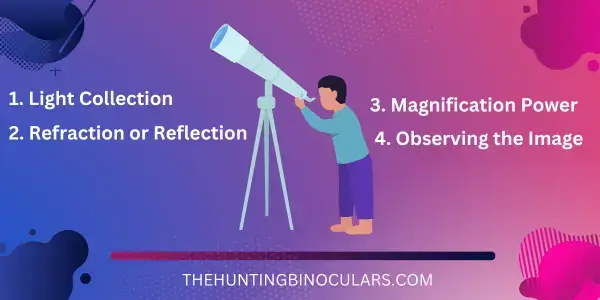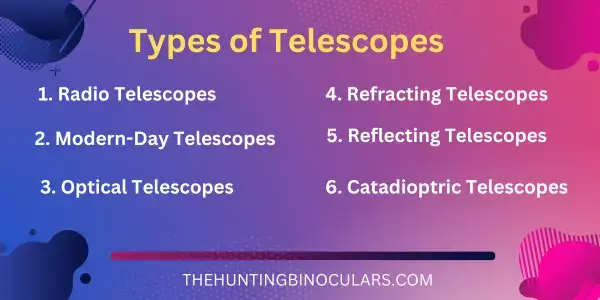
Telescopes have long been an essential tool for astronomers and stargazers alike. Their ability to magnify distant celestial objects and bring them closer to us has ignited curiosity and awe about the universe. But have you ever wondered how these marvelous instruments work?
In this article, we will take you on a journey to demystify how does a telescope work. From the earliest refractors to the modern marvels of space exploration, we will explore the intricacies of telescopes, shedding light on the mysteries of the cosmos.
Table of Contents
- How Does a Telescope Work | History, Types, & Facts
- The Evolution of Telescopes: From Galileo to Space Telescopes
- Other Types of Telescopes
- Telescopes Used for What Purpose
- Telescopes for Astrophotography: Capturing the Cosmos
- Radio Telescopes: Listening to the Stars’ Whispers
- Parabolic Reflectors: Capturing Radio Waves
- Radio Interferometry: Uniting Telescopes for Precision
- Applications of Radio Telescopes: Pulsars, Quasars, and More
- Space Telescopes: Observing Beyond Earth’s Atmosphere
- The Hubble Space Telescope: A Window to the Universe
- The James Webb Space Telescope (JWST): A New Frontier
- FAQs
How Does a Telescope Work | History, Types, & Facts
At its core, a telescope is a device designed to collect and amplify light, allowing us to observe celestial objects with enhanced clarity. The process of how a telescope works can be broken down into several essential steps:
1. Light Collection
A telescope’s primary function is to gather as much light as possible from distant objects in space. The larger the telescope’s aperture, the more light it can collect. This light-gathering ability is crucial for observing faint and distant celestial bodies.
2. Refraction or Reflection
There are two main types of telescopes: refractors and reflectors. Refracting telescopes use lenses to bend light while reflecting telescopes utilize mirrors to reflect light. Both methods focus the light on a single point, forming an image for us to observe.
3. Magnification Power
Once the light has been collected and focused, the telescope’s eyepiece magnifies the image, making it appear larger and more detailed. The magnification power depends on the combination of lenses or mirrors used in the telescope.
4. Observing the Image
The magnified image is what we observe through the eyepiece or, in modern telescopes, via digital imaging systems. This enables us to witness celestial wonders that would otherwise remain invisible to the naked eye.

The Evolution of Telescopes: From Galileo to Space Telescopes
Humanity’s quest to understand the cosmos has driven the continuous improvement and innovation of telescopes. Let’s delve into the evolution of telescopes and their revolutionary milestones:
Galileo’s Refracting Telescope: Unveiling the Moon
In the early 17th century, the renowned Italian astronomer Galileo Galilei made a groundbreaking discovery by pointing his newly crafted refracting telescope toward the moon. This revealed a whole new world of craters, mountains, and valleys, challenging the prevailing beliefs about celestial bodies.
Newtonian Reflecting Telescope: A New Era in Astronomy
In the late 17th century, Sir Isaac Newton revolutionized telescope design with the invention of the reflecting telescope. By replacing lenses with mirrors, he eliminated chromatic aberration, significantly enhancing image quality. This innovation laid the foundation for modern reflector telescopes.
The Hubble Space Telescope: Peering into the Deep Cosmos
Launched into orbit in 1990, the Hubble Space Telescope is one of the most iconic space observatories. Positioned above Earth’s atmosphere, it captures breathtaking images of distant galaxies, nebulae, and other cosmic phenomena, offering unprecedented insights into the universe’s vastness.
Other Types of Telescopes
1. Radio Telescopes (Listening to the Stars)
While optical telescopes use visible light, radio telescopes detect radio waves emitted by celestial objects. These specialized instruments have allowed astronomers to study cosmic events like pulsars, quasars, and cosmic background radiation.
2. Modern-Day Telescopes: Advancements and Discoveries
With the advent of cutting-edge technologies, astronomers now have access to various advanced telescopes, such as the Kepler Space Telescope and the James Webb Space Telescope (JWST). These instruments have enabled groundbreaking discoveries, including exoplanet identification and the study of distant galaxies.
3. Optical Telescopes: Revealing the Visible Universe
Optical telescopes are the most familiar type of telescope, and they are primarily used to observe visible light emitted or reflected by celestial objects. Let’s explore the different types of optical telescopes and their unique characteristics:
4. Refracting Telescopes: The Classic Design
Refractors employ lenses to bend and focus light, producing clear and crisp images. They are ideal for observing bright objects like planets, the moon, and double stars. However, chromatic aberration can be an issue with larger refractors.
5. Reflecting Telescopes: Mirrors Unleashed
Reflectors use mirrors to gather and focus light, eliminating chromatic aberration. They are well-suited for observing faint objects like galaxies, nebulae, and star clusters. The Newtonian and Cassegrain designs are popular examples of reflecting telescopes.
6. Catadioptric Telescopes: The Best of Both Worlds
Catadioptric telescopes combine lenses and mirrors, offering a compact and versatile design. The Schmidt-Cassegrain and Maksutov-Cassegrain telescopes fall into this category, providing exceptional image quality and portability.

Telescopes Used for What Purpose
Telescopes for Astrophotography: Capturing the Cosmos
Astrophotography enthusiasts often use specialized telescopes designed for capturing stunning images of celestial objects. These telescopes have precise tracking systems and larger apertures, allowing for long-exposure photography.
Radio Telescopes: Listening to the Stars’ Whispers
Radio telescopes are an essential tool in modern astronomy, enabling us to listen to radio waves emitted by various celestial sources. Let’s explore the workings of these fascinating instruments:
Parabolic Reflectors: Capturing Radio Waves
Radio telescopes employ parabolic reflectors, similar to their optical counterparts, but they collect and focus radio waves instead of visible light. The shape of the reflector is crucial for accurately capturing these faint signals.
Radio Interferometry: Uniting Telescopes for Precision
Radio interferometry involves combining signals from multiple radio telescopes, creating a virtual telescope with a diameter equal to the distance between the telescopes. This technique provides exceptional resolution for observing distant radio sources.
Applications of Radio Telescopes: Pulsars, Quasars, and More
Radio telescopes have been instrumental in the discovery and study of various cosmic phenomena, including pulsars, quasars, and cosmic microwave background radiation. They also play a crucial role in monitoring space weather.
Space Telescopes: Observing Beyond Earth’s Atmosphere
Space telescopes have unlocked new dimensions of astronomical exploration by escaping the limitations of Earth’s atmosphere. Here’s a glimpse into the wonders of space telescopes:
The Hubble Space Telescope: A Window to the Universe
The Hubble Space Telescope, launched by NASA and ESA, has transformed our understanding of the cosmos. Positioned above Earth’s atmosphere, it captures crystal-clear images of galaxies, nebulae, and other distant objects.
The James Webb Space Telescope (JWST): A New Frontier
Scheduled for launch, the JWST is poised to be the most powerful space telescope ever built. Equipped with advanced instruments, it will explore the universe in infrared wavelengths, unveiling unseen cosmic phenomena.
FAQs
How does a telescope work in space?
In space, telescopes like the Hubble Space Telescope avoid interference from Earth’s atmosphere, allowing them to capture sharper and clearer images of distant celestial objects.
Can I see planets with a telescope?
Yes, even small telescopes can reveal fascinating details of planets like Jupiter’s moons, Saturn’s rings, and Martian polar ice caps.
Are radio telescopes only for listening?
While radio telescopes excel at listening to radio waves from space, they can also transmit signals to communicate with spacecraft and study the Earth’s atmosphere.
What is the difference between a refracting and reflecting telescope?
Refracting telescopes use lenses to bend light while reflecting telescopes use mirrors to focus light. Both designs have their advantages and limitations.
How do I choose the right telescope for astrophotography?
Consider factors like the telescope’s focal length, aperture, and mount stability to find the ideal instrument for capturing stunning astrophotography images.
Can I observe the stars during the daytime with a telescope?
While it is technically possible to observe stars during the daytime with a telescope, it is extremely challenging due to the brightness of the sun’s light.
Conclusion
Telescopes have opened up new realms of knowledge, allowing us to marvel at the beauty and complexity of the universe. From the earliest days of Galileo’s refractor to the state-of-the-art space telescopes, these remarkable instruments have broadened our understanding of the cosmos. Whether you’re an amateur stargazer or a seasoned astronomer, the magic of telescopes never fails to inspire wonder and curiosity.
So, the next time you gaze through the eyepiece of a telescope and witness the distant stars and galaxies, take a moment to appreciate the ingenious mechanics and optics that make it all possible.
